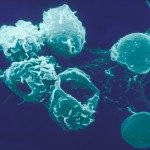Link to Pubmed [PMID] – 16020514
Blood 2005 Nov;106(9):3004-11
The existence of macrophages (Mphi) of yolk-sac (YS) origin has been reported in all vertebrate models. However, the nature of their precursors and pathways of differentiation have not been elucidated. Phenotypic and differentiation potential analyses of YS at 7.5 to 10 postcoital days (dpc), performed in CX3CR1(GFP) embryos, allowed us to discern 3 independent Mphi populations. A first transient wave consisted of mature, maternal-derived Mphipresent as early as 7.5 to 8 dpc. A second wave of committed Mphi precursors arose at 8 dpc (2-4 somite stage) and was followed by a third wave of erythromyeloid precursors (4-6 somite stage). Both types of precursors displayed similar phenotypes and gave rise to CX3CR1/green fluorescent protein (GFP)-positive Mphi, but differed by their differentiation potential, at the clonal level. The combined data of phenotypic, gene-expression, and in situ analyses allowed us to conclude that the previously named “primitive Mphi” corresponded to a mixture of the first transient wave and committed Mphi precursors. Both YS-derived precursors followed a developmental pathway common to adult Mphi and could be qualified as definitive.


